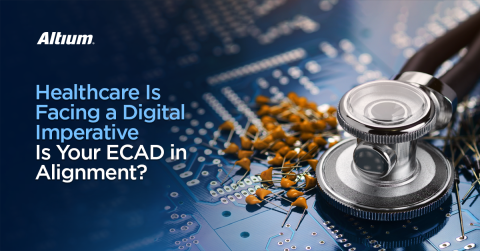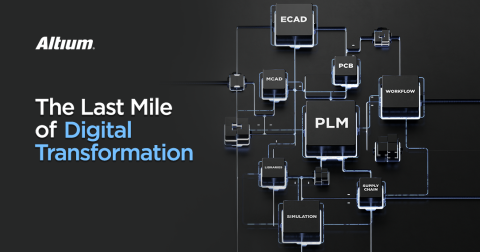Electrification and Digitalization are Driving the Automotive Industry

It's hard to imagine that not too many decades ago, the most complicated and only "electronics" the average car had was just simply – a radio. Typically, a basic AM/FM device might have had an 8-track or a cassette player made up of a single PCB utilizing thru-hole technology and maybe an IC or two.

Examples of early automotive computers / electronics. Image credit chipsetc.com
Over time, advancing electronics became critical for almost every automotive function to control, optimize, or outright replace mechanical components. Increasingly sophisticated electronics are completely responsible for engine management that optimizes fuel economy and reduces emissions, control systems such as anti-lock brakes and obstacle avoidance that improve safety, and that simple radio became a high-end "infotainment" system that enhances the driving experience.

Extensive automotive computers and electronics systems. Image credit chipsetc.com
The modern car has essentially become a computer on wheels. Outwardly, it still looks like a car that Henry Ford would recognize. But under the hood the once purely mechanical automobile is now a complex collection of highly-integrated computer systems with dozens of microprocessors, complex software running millions of lines of code, and modern electronics all working together just to get it started and out of the driveway.
“People want to be able to trust this technology”
- Joe Borland, Director of Engineering, Veoneer

ECAD Drives The Modern Car
Modern car design heavily depends on a precise convergence and integration of its electronic systems, mechanical, and software components involving engineering teams – both internal and external –, numerous suppliers, manufacturers, and more.
For companies and organizations designing automotive electronic systems, complexity is increasing fast. The automotive electronics market is expected to grow from ~$230 billion (USD) in 2021 to almost ~$400 billion (USB) by 2028. One of the key drivers is advanced safety and vehicle autonomy which will see the evolution of almost every electronic system and the introduction of countless new systems being added to an already crowded automotive platform. This will, in turn, lead to new design and integration challenges that along with additional regulatory requirements – especially for safety and reliability – must be addressed together by vendors, OEMs, and suppliers.
To design and deliver modern automotive products and systems, automotive ECAD organizations need to integrate, communicate, and collaborate effectively across engineering domains, stakeholders, and manufacturing partners throughout the product development process.
Veoneer, a world leader in automotive safety and electronic control systems, has recognized the importance of aligning and digitally connecting their ECAD with the larger automotive product development. Joe Borland, Director of Engineering at Veoneer, has seen a lot of changes in design complexity in the industry. "Electronics and the automotive industry are in an evolutionary period; it used to be very simple."

copyright Veoneer
Digitalization Will Drive Everything
Even as automotive electronics technologies and systems continue to evolve, the automotive industry as a whole is rapidly evolving at an unprecedented rate. Automakers and suppliers are in the midst of a historic transformation as they adapt to evolving market conditions, changing customer expectations, and new regulatory requirements. Digitalizing product development makes it possible to integrate business management across enterprise organizations. This seamless integration can bring new visibility to sales experiences, logistics capabilities, manufacturing, and maintenance.
For electronic product development, digitalization enables companies and design organizations to address a wide range of product and industry challenges.
- A Crowded Field of Design Partners
As automotive technologies and innovations continue to advance, the challenge for automakers is not only to design new features but also to integrate them into vehicles in a way that is both safe and practical. The automotive development process becomes even more challenging because many new technologies are developed by suppliers and partners rather than in-house.
The automotive industry increasingly relies on distributed development models to create complex electronic systems and modules. Distributed product development models can create significant complexities in terms of integrating disparate systems from multiple partners into an already crowded automotive platform.
While working with partners is not new, automotive technologies have rapidly increased in quantity and complexity over the years, putting more pressure on distributed teams to ensure that all systems function correctly.
- Increasing Regulatory Requirements
Automotive technologies have come a long way in recent years, with cars now boasting an impressive array of electronic systems that rival those in the most advanced aircraft. As technology advances, the design and integration of new electronic systems become increasingly complex. The automotive industry must address increasing regulatory, testing, and compliance requirements for environmental sustainability, quality, and above all – safety.
- The Rise of Product Lifecycle Management
Product Lifecycle Management (PLM), a process that helps companies improve their business operations, logistics, and product development, is essential for any industry embracing digital transformation. In fact, automotive industry manufacturers and suppliers are spending more money on PLM software than any other industry. Automotive PLM investments are projected to grow from $5.1 billion in 2017 to over $8 billion in 2022.
PLM systems have become more advanced over the years, evolving to better meet the needs of people who create or manage electronics design. PLM helps enterprises efficiently navigate the complexities of compliance regulations and the interfaces needed for electronics design teams, manufacturers, and suppliers. Managing enterprise complexity is essential for digitally transforming ECAD design environments.
- Collaboration and Communication
Recent estimates put the value of electronics in a car at about 40% of the total cost. Today, there are over 1,000 chips in a non-electric car and twice that in an electric one. Throw in millions of lines of software code, and it's no wonder the modern automobile is often referred to as a 'computer on wheels’ requiring a significant amount of cross-domain collaboration and communication as part of product development.
Electrical and mechanical design teams must collaborate regularly and effectively to ensure form and fit of complex automotive modules and control systems. This communication and collaboration must also extend between the vendor and supplier as automotive electronics are integrated into the larger automotive platform.
“Altium allows us to do better project management and better management of the boards.”
- Joe Borland, Director of Engineering, Veoneer
Driving A Digitally-Integrated ECAD Environment
Veoneer's PCB design team utilizes the digitally-integrated Altium enterprise design solution and its digital connectivity between ECAD and their PLM. This connection creates a digital thread that acts as a single source of truth to streamline product development, manage libraries and design content, and help comply with regulatory compliance requirements. The Altium design solution empowers the Veoneer teams to:
- Standardize processes to ensure consistency and best practices through managed workflows
- Make earlier and informed part choices via on-demand supply-chain visibility
- Eliminate manual, error-prone practices with automated, company-defined processes
- Easily access, communicate, review and share project data with extended team members electronically via a standard web browser
- Fully trace and audit product trails throughout the project's lifecycle and decision tree history
With Altium enterprise solutions, Veoneer has accelerated their development speed while helping to ensure the safety and reliability of its products.

Joe Borland talks about how Altium enterprise solutions enable Veoneer, a worldwide leader in automotive technology, to accelerate development speed while ensuring, above all else, safety and reliability of their products --- strengthening their purpose of “Creating Trust in Mobility”.
What’s Driving Your ECAD Environment?
By digitally-connecting electronics design to existing technology investments – including PLM, MCAD, and simulation – Altium enterprise solutions allow companies to seamlessly integrate their product development teams and processes from concept to realization. In addition, digitally-managed process workflows, along with connected resources, enable intuitive and valuable collaboration across domains and disciplines.
The digital continuity that Altium enterprise solutions provide enables project challenges to be addressed and decisions to be made at the critical points of impact – when they matter most.
The Altium enterprise solutions are the most lightweight, easy-to-implement electronics design solutions for enterprise organizations of all sizes or maturity, making the last mile of digital transformation not only possible – but easy. Altium is transforming electronics design.






